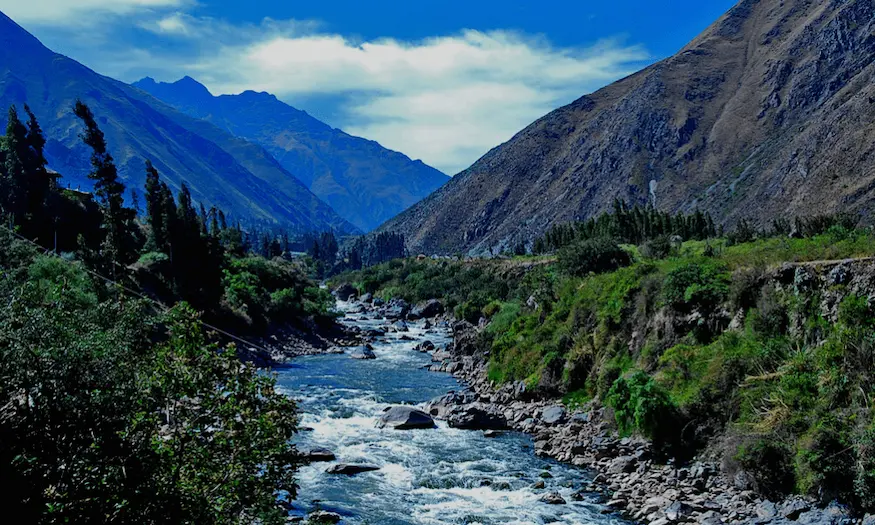Urubamba River
The Urubamba River, often called the Sacred River by the Incas, is more than just a body of water flowing through the Sacred Valley in Peru. This river has played a crucial role in shaping the history, culture, and environment of this ancient region. Flowing from the Vilcanota River, the Urubamba stretches through the valleys and mountains, reaching the famous town of Aguas Calientes and circling the base of the legendary Machu Picchu.
In this blog, we’ll explore why the Urubamba River is so important, how it connects with the Sacred Valley, and what makes it such a special part of the Peruvian landscape.

The Journey of the Urubamba River
The Urubamba River begins as the Vilcanota River, high up in the Andean mountains. It flows through deep valleys, passing through several villages and historical sites. As it travels, the river takes on the name Urubamba as it enters the Sacred Valley. This river is essential for agriculture, transportation, and the spiritual life of the people who have lived here for centuries.
As the river flows through the Sacred Valley, it nourishes the fertile lands, allowing crops like corn and potatoes to thrive. The Incas viewed this river as sacred because it provided life to their people. For the Incas, rivers were seen as spiritual entities, and the Urubamba was no exception.
The river’s journey continues through the town of Ollantaytambo, winding its way toward Aguas Calientes, the gateway to Machu Picchu. As the river nears Machu Picchu, its course becomes narrower and faster, cutting through dramatic canyons that add to the mystique of this UNESCO World Heritage site.
The Urubamba River and the Sacred Valley
The Sacred Valley is one of the most fertile and historically significant regions in Peru. The river’s presence in this valley is vital. It feeds the agricultural terraces and fields that have been used for centuries, making it one of the most productive agricultural areas in the Inca Empire.
The valley is surrounded by towering mountains and dotted with Inca ruins, all linked in some way to the flow of the Urubamba River. Villages like Pisac, Ollantaytambo, and Yucay were strategically built along its banks, taking advantage of the fertile soil and easy access to water.
A Sacred River for the Inca
The Urubamba was considered a sacred river by the Incas. They believed it mirrored the flow of the Milky Way in the night sky. It wasn’t just important for agriculture; it was also deeply connected to their religious beliefs. The Incas built important temples and ceremonial sites along the river, believing it had divine properties.
For instance, Machu Picchu, the iconic Inca citadel, was built high above the river on a mountain ridge. The placement of the site was no accident. It’s believed that the flow of the Urubamba helped guide the Incas in deciding where to build this mysterious and magical city.
The River’s Role in Machu Picchu
The Urubamba River plays a vital role in the story of Machu Picchu. As it flows around the base of this ancient city, the river creates a natural barrier that protected Machu Picchu from invaders and provided water for the inhabitants. The Incas were master engineers, and they built aqueducts and canals to bring water from the river to the city. The river’s presence was a key reason why Machu Picchu could be built and sustained in such an isolated location.
The river also creates a beautiful backdrop for visitors today. Whether you’re hiking the Inca Trail, visiting the ruins, or simply relaxing in Aguas Calientes, the sound of the Urubamba River adds to the atmosphere, making your experience even more special.
Adventure on the Urubamba River
Today, the Urubamba River offers more than just historical significance; it’s also a hub for adventure. The river’s fast-flowing waters make it a popular destination for white-water rafting. Tourists can take guided rafting trips through various sections of the river, experiencing the thrill of navigating rapids while surrounded by some of the most stunning scenery in the world.
For those looking for a less intense experience, there are also calm sections of the river where you can enjoy a peaceful boat ride, taking in the dramatic landscape that has remained unchanged for centuries.
Final Thoughts on the Sacred River
The Urubamba River is more than just a river; it’s the lifeblood of the Sacred Valley and a symbol of the powerful connection between nature and the Inca civilization. From its origins as the Vilcanota River to its journey past Machu Picchu, the river flows through the heart of Peru’s history and continues to shape the landscape today.
Whether you’re interested in history, adventure, or simply soaking in the natural beauty of Peru, the Urubamba River is an essential part of the experience. As the sacred river of the Incas, its presence will forever be linked to the spiritual and physical well-being of this remarkable region.
FAQs
1. Is the Urubamba River sacred?
Yes, the Incas considered the Urubamba River to be sacred. It was essential for agriculture and connected to their spiritual beliefs.
2. Can you raft on the Urubamba River?
Yes! The Urubamba offers excellent white-water rafting opportunities, with sections of the river that cater to both beginners and experienced rafters.
3. Does the Urubamba River flow through Machu Picchu?
Yes, the river flows around the base of Machu Picchu, adding to the site’s natural beauty and providing water for the ancient city.
4. Why is the Urubamba River important to the Sacred Valley?
The Urubamba River nourishes the fertile lands of the Sacred Valley, enabling agriculture and sustaining life in this important region of Peru.
Cusco - Machu Picchu
Cusco
Cusco
Cusco
Inca Trail hike
Inca Trail hike
Salkantay trekking
biking rafting zip line
Inca Trail
Inca Trail
